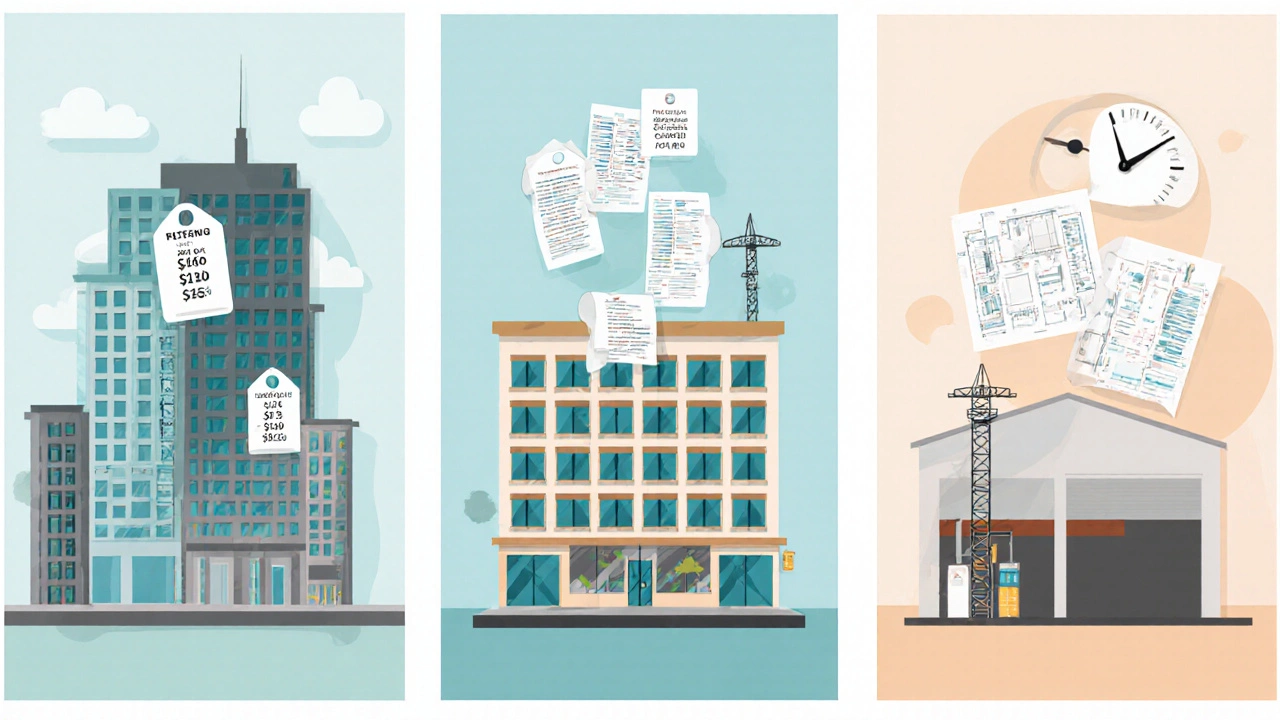Commercial Property Valuation Calculator
Estimated Market Value
How It Works
This calculator uses the Income Approach, which is commonly used for income-producing commercial properties.
Formula: Value = Net Operating Income ÷ Capitalization Rate
Where:
- Net Operating Income (NOI) = Gross Rental Income - Operating Expenses
- Capitalization Rate = Annual return expected by investors
Sales Comparison
Best for properties with recent comparable transactions
Income Approach
Ideal for income-producing assets like offices or retail
Cost Approach
Useful for special-purpose or newly built properties
Key Takeaways
- Three main valuation methods: sales comparison, income approach, and cost approach.
- Pick a qualified valuer with relevant experience and professional accreditation.
- Gather lease agreements, recent expenses, floor plans, and planning permissions before the inspection.
- Typical fees range from 0.5% to 1.5% of the property value, plus possible disbursements.
- Expect a detailed report within 2-4 weeks after the site visit.
When you hear the phrase commercial valuation, you might picture a dusty office, a pile of paperwork, and a number that seems to appear out of thin air. In reality, a solid valuation is a step‑by‑step process that blends data, market knowledge, and professional judgment. Whether you’re selling, refinancing, or just curious about your asset’s worth, knowing how to get a reliable commercial valuation saves you time, money, and headaches.
Commercial valuation is a formal assessment of the market value of a commercial property, performed by a qualified valuer using recognized methodologies. It provides an unbiased opinion that lenders, investors, and regulators rely on for decision‑making.
What Exactly Is a Commercial Valuation?
A commercial valuation estimates the price a willing buyer would pay for a property on the open market, assuming a willing seller. It differs from a tax assessment or a simple ball‑park estimate because it follows professional standards (e.g., RICS Red Book) and includes detailed analysis of income, costs, and comparable sales.
Key components of a typical valuation report include:
- Executive summary with the concluded market value.
- Property description (size, layout, condition).
- Market overview (local vacancy rates, rental trends).
- Valuation methodology and calculations.
- Assumptions and limiting conditions.
When Should You Order a Valuation?
Most owners seek a valuation at five critical moments:
- Financing: Banks require a fresh valuation before approving a loan or refinancing.
- Sale or purchase: Buyers and sellers need an objective value to negotiate fair terms.
- Portfolio review: Investors periodically re‑value assets to assess performance.
- Insurance: To set appropriate coverage limits.
- Legal disputes: Courts often rely on an expert valuation in divorce or partnership break‑ups.

How Valuations Are Done - The Three Main Methods
Professional valuers choose the most suitable approach-or a blend-based on the property type, data availability, and the purpose of the valuation.
| Method | Best For | Main Data Inputs | Typical Accuracy |
|---|---|---|---|
| Sales Comparison | Properties with recent comparable transactions | Recent sale prices, location, size, condition | High - if many recent comps exist |
| Income Approach | Income‑producing assets (offices, retail, industrial) | Net operating income, capitalization rate, rent rolls | Very high - reflects cash‑flow reality |
| Cost Approach | Special‑purpose or newly built properties | Replacement cost, depreciation, land value | Moderate - assumes cost data is reliable |
Let’s unpack each method a bit.
Sales Comparison
Also called the market approach, this method looks at what similar properties have sold for in the last six to twelve months. The valuer adjusts for differences - a larger floor plate, better location, or recent refurbishments - to arrive at a value that reflects local market sentiment.
Income Approach
For lease‑back assets, the income approach is king. The valuer calculates the Net Operating Income (NOI) by subtracting operating expenses from gross rental income, then applies a capitalization (cap) rate derived from market data. The formula is simple: Value = NOI ÷ Cap Rate.
Cost Approach
This method starts with the current cost to rebuild the structure (including labor, materials, and professional fees), subtracts physical depreciation, and adds the land’s market value. It’s handy when there are few comparable sales, such as a purpose‑built data centre.
Choosing the Right Valuer
Not every appraiser can deliver a credible commercial valuation. Look for these hallmarks:
- Professional accreditation - e.g., RICS Chartered Valuer, ICMA‑UK Certified Valuer.
- Experience with the specific asset class (office, retail, industrial, mixed‑use).
- Clear fee structure and timeline.
- References or case studies of similar projects.
- Insurance coverage for professional liability.
Ask potential valuers for a brief proposal outlining the methodology they intend to use. A transparent plan reduces surprise later on.
Preparing Your Property for Valuation
The valuer’s job is easier - and your report more accurate - when you supply the right paperwork up front. Gather these items:
- Title deeds and land registry extract.
- Current lease agreements, rent rolls, and service charge statements.
- Operating expense breakdown (maintenance, utilities, management fees).
- Floor plans, as‑built drawings, and any recent refurbishment invoices.
- Planning permissions, zoning certificates, and environmental reports.
- Recent comparable sales data (if you have it).
When the valuer visits, ensure the site is clean, safe, and accessible. Minor cosmetic fixes can improve the perception of condition and may shave a few percentage points off depreciation estimates.
What the Valuation Report Looks Like
A well‑structured report follows a predictable flow:
- Cover page with client details and valuation purpose.
- Executive summary - the headline value and key conclusions.
- Property description - size, layout, age, condition.
- Market analysis - vacancy rates, comparable rents, recent sales.
- Methodology - which approach was used and why.
- Calculations - step‑by‑step figures supporting the final value.
- Assumptions and limiting conditions - what the valuer assumed (e.g., stable interest rates) and any constraints (e.g., data gaps).
- Appendices - maps, photographs, and supporting data tables.
Read the assumptions carefully; they often explain why the value might differ from a buyer’s offer.

Costs and Timeline
Fees vary by market, property size, and complexity. In the UK, you’ll typically see:
- Flat fee for small offices (under 5,000 sq ft): £1,200‑£2,500.
- Percentage‑based fee for larger assets: 0.5%‑1.5% of the estimated value.
- Additional charges for travel, specialist reports (e.g., environmental), or rush orders.
Turnaround time is usually 2-4 weeks after the site inspection, but if you need a rapid valuation for a time‑sensitive transaction, ask for an expedited service - it may add 20%‑30% to the fee.
Common Pitfalls and How to Avoid Them
- Using an unqualified valuer - results may be challenged by lenders, costing you extra time.
- Providing incomplete data - missing lease terms or expense details can skew the income approach.
- Relying on outdated comparable sales - markets in London and major UK cities can shift dramatically within six months.
- Ignoring the valuation purpose - a valuation for tax purposes may need a different approach than one for a sale.
- Over‑looking cap‑rate trends - an outdated cap rate can under‑ or over‑value the asset.
Address these early, and you’ll get a valuation that stands up to scrutiny.
Next Steps After Receiving Your Valuation
Once the report lands on your desk, consider these actions:
- Review the executive summary and verify the key assumptions.
- Discuss any surprising findings with the valuer - ask for clarification or a sensitivity analysis.
- If you’re selling, use the value as a baseline for setting your asking price.
- For refinancing, present the report to your lender and negotiate loan terms based on the confirmed value.
- Update your asset register and insurance coverage to reflect the new market value.
Remember, a valuation is a snapshot. Markets evolve, so schedule periodic reviews (every 2-3 years) or whenever a major event occurs.
Frequently Asked Questions
How long does a commercial valuation usually take?
Most valuers need 1-2 days for a site visit, then 2-4 weeks to compile the report. Rush services can cut this to 5‑7 days for an additional fee.
Do I have to pay the valuer up front?
Typically, valuers ask for a deposit (20%‑30%) before starting, with the balance due on delivery of the report. Some firms may invoice after completion.
Can I use the valuation for tax assessment?
Yes, but ensure the valuer follows the HMRC‑approved methodology and includes a statement that the figure is suitable for tax purposes.
What’s the difference between a market value and an investment value?
Market value reflects the price a typical buyer would pay in an arm’s‑length transaction. Investment value is the worth to a specific investor, taking into account unique synergies or strategic goals.
Do I need a valuation if I’m just refinancing a loan?
Most lenders require a fresh, independent valuation to confirm the collateral’s current market value before approving a refinance.

